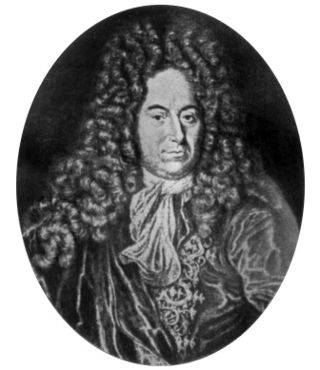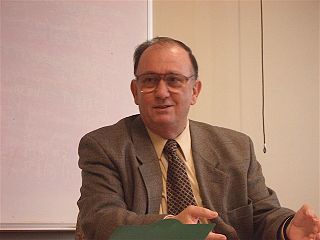Related Research Articles

Physics is a branch of science whose primary objects of study are matter and energy. Discoveries of physics find applications throughout the natural sciences and in technology. Historically, physics emerged from the scientific revolution of the 17th century, grew rapidly in the 19th century, then was transformed by a series of discoveries in the 20th century. Physics today may be divided loosely into classical physics and modern physics.

The magic lantern, also known by its Latin name lanterna magica, was an early type of image projector that used pictures—paintings, prints, or photographs—on transparent plates, one or more lenses, and a light source. Because a single lens inverts an image projected through it, slides were inserted upside down in the magic lantern, rendering the projected image correctly oriented.

Christiaan Huygens, Lord of Zeelhem, was a Dutch mathematician, physicist, engineer, astronomer, and inventor who is regarded as a key figure in the Scientific Revolution. In physics, Huygens made seminal contributions to optics and mechanics, while as an astronomer he studied the rings of Saturn and discovered its largest moon, Titan. As an engineer and inventor, he improved the design of telescopes and invented the pendulum clock, the most accurate timekeeper for almost 300 years. A talented mathematician and physicist, his works contain the first idealization of a physical problem by a set of mathematical parameters, and the first mathematical and mechanistic explanation of an unobservable physical phenomenon.
Laurent Cassegrain was a Catholic priest who is notable as the probable inventor of the Cassegrain reflector, a folded two-mirror reflecting telescope design.
The year 1657 in science and technology involved some significant events.

In the differential geometry of curves, the evolute of a curve is the locus of all its centers of curvature. That is to say that when the center of curvature of each point on a curve is drawn, the resultant shape will be the evolute of that curve. The evolute of a circle is therefore a single point at its center. Equivalently, an evolute is the envelope of the normals to a curve.

Nicolas Fatio de Duillier was a mathematician, natural philosopher, astronomer, inventor, and religious campaigner. Born in Basel, Switzerland, Fatio mostly grew up in the then-independent Republic of Geneva, of which he was a citizen, before spending much of his adult life in England and Holland. Fatio is known for his collaboration with Giovanni Domenico Cassini on the correct explanation of the astronomical phenomenon of zodiacal light, for inventing the "push" or "shadow" theory of gravitation, for his close association with both Christiaan Huygens and Isaac Newton, and for his role in the Leibniz–Newton calculus controversy. He also invented and developed the first method for fabricating jewel bearings for mechanical watches and clocks.

Eduard Jan Dijksterhuis was a Dutch historian of science.
The Ryom-Verzeichnis or Ryom Verzeichnis is the standard catalogue of the music of Antonio Vivaldi created by Danish musicologist Peter Ryom. Verzeichnis is the German word for catalogue. First published in 1973 under the title Antonio Vivaldi: Table de Concordances des Œuvres (RV), the Ryom-Verzeichnis has existed in several forms over the course of its development. The catalogue is often used to identify Vivaldi's works by a simple number.

Leopoldo de' Medici was an Italian cardinal, scholar, patron of the arts and Governor of Siena. He was the brother of Ferdinando II de' Medici, Grand Duke of Tuscany.
Alfred Wotquenne was a Belgian musical bibliographer, best known for his catalogues of the works of Carl Philipp Emanuel Bach and Christoph Willibald Gluck.

The Complete Work of Charles Darwin Online is a freely-accessible website containing the complete print and manuscript works of Charles Darwin, as well as related supplementary material.

Centrifugal force is a fictitious force in Newtonian mechanics that appears to act on all objects when viewed in a rotating frame of reference. It is directed radially away from the axis of rotation. The magnitude of centrifugal force F on an object of mass m at the distance r from the axis of rotation of a frame of reference rotating with angular velocity ω is:

Eustachio Divini was an Italian manufacturer and experimenter of optical instruments for scientific use in Rome.

Krishna Venkateswara Sarma (1919–2005) was an Indian historian of science, particularly the astronomy and mathematics of the Kerala school. He was responsible for bringing to light several of the achievements of the Kerala school. He was editor of the Vishveshvaranand Indological Research Series, and published the critical edition of several source works in Sanskrit, including the Aryabhatiya of Aryabhata. He was recognised as "the greatest authority on Kerala's astronomical tradition".

Rømer's determination of the speed of light was the demonstration in 1676 that light has an apprehensible, measurable speed and so does not travel instantaneously. The discovery is usually attributed to Danish astronomer Ole Rømer, who was working at the Royal Observatory in Paris at the time.

Michael Edward Stone is a professor emeritus of Armenian Studies and of Comparative Religion at the Hebrew University of Jerusalem. His research deals with Armenian studies and with Jewish literature and thought of the Second Temple period. He is also a published poet.

Cornelis Dirk (Cees) Andriesse is a Dutch physicist, writer and historian of science. Internationally he is best known for his scientific biography of Christiaan Huygens.

Horologium Oscillatorium: Sive de Motu Pendulorum ad Horologia Aptato Demonstrationes Geometricae is a book published by Dutch mathematician and physicist Christiaan Huygens in 1673 and his major work on pendula and horology. It is regarded as one of the three most important works on mechanics in the 17th century, the other two being Galileo’s Discourses and Mathematical Demonstrations Relating to Two New Sciences (1638) and Newton’s Philosophiæ Naturalis Principia Mathematica (1687).

Treatise on Light: In Which Are Explained the Causes of That Which Occurs in Reflection & Refraction is a book written by Dutch polymath Christiaan Huygens that was published in French in 1690. The book describes Huygens's conception of the nature of light propagation which makes it possible to explain the laws of geometrical optics shown in Descartes's Dioptrique, which Huygens aimed to replace.
References
- 1 2 Van Dyck, Maarten (June 2015). "Joella G. Yoder . A Catalogue of the Manuscripts of Christiaan Huygens, Including a Concordance with His Oeuvres Complètes". Isis. 106 (2): 446-.
- ↑ "2020-2021 Annual Report" (PDF). Village Theatre. Retrieved September 7, 2024.
- ↑ Cohen, H. Floris (March 1991). "Review: How Christiaan Huygens Mathematized Nature" (PDF). The British Journal for the History of Science. 24 (1): 79–84. JSTOR 4027017.
- ↑ Barbour, J. G. (1989). "A review of Unrolling Time: Christiaan Huygens and the Mathematization of Nature. By Joella G. Yoder. (Cambridge University Press, 1989.)". Contemporary Physics. 30 (6): 467=468. doi:10.1080/00107518908221994.